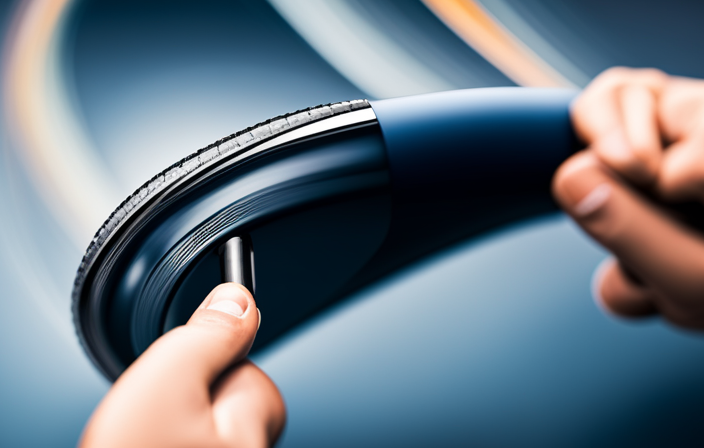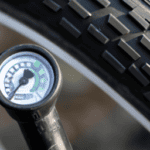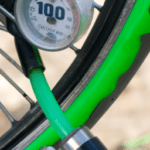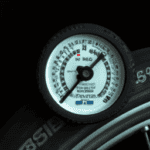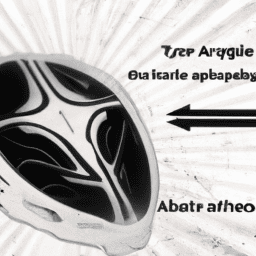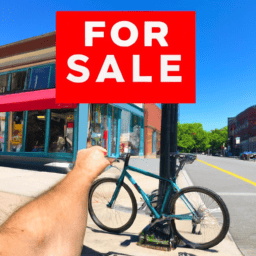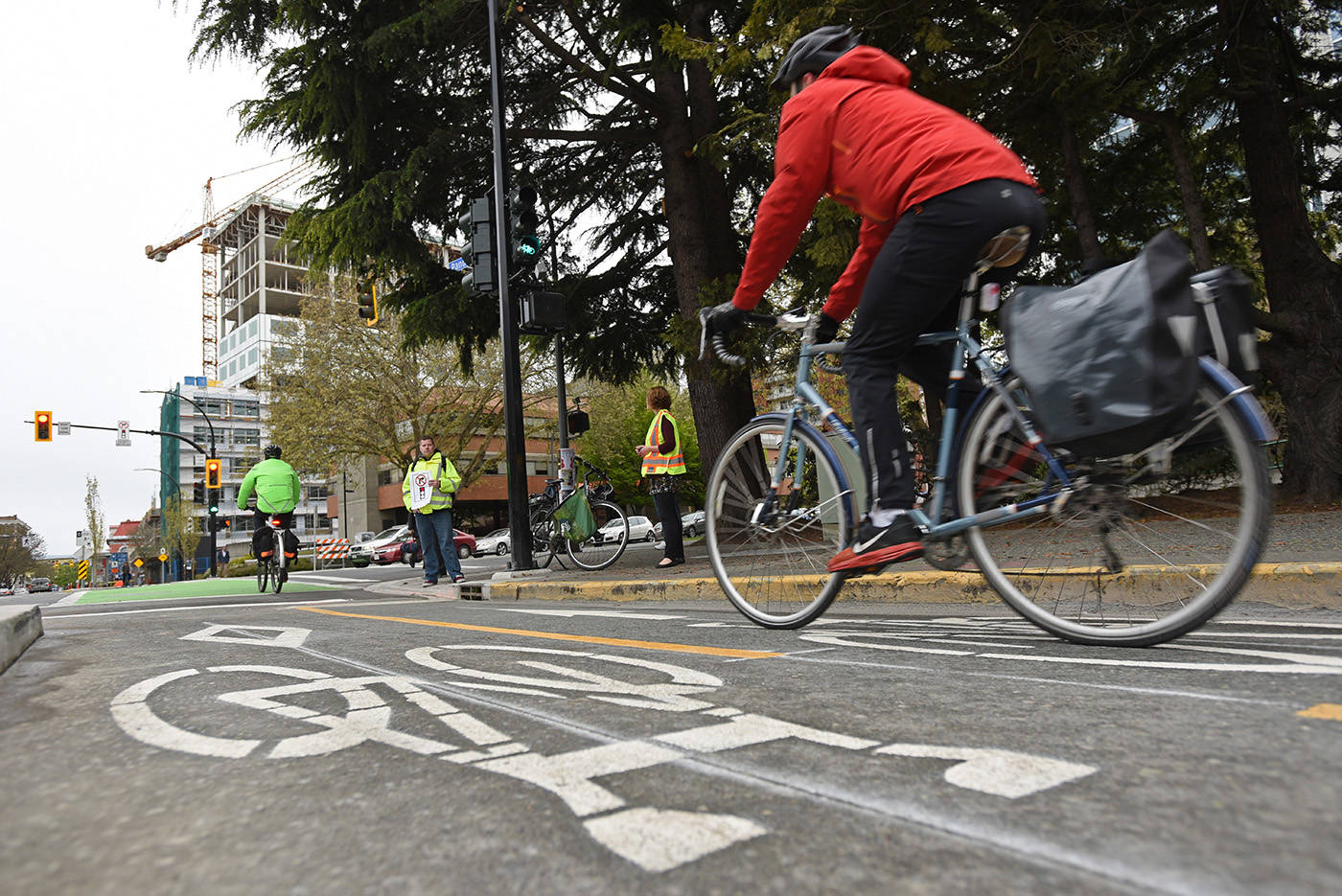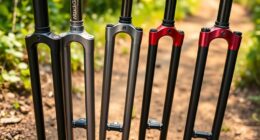Riding my bicycle using pedal power pushes me ahead, feeling the wind blowing through my hair as I journey down the open road. To guarantee a smooth and secure ride, I must not forget about the important factor of tire pressure.
Determining the ideal PSI for my bicycle tire is key to maximizing performance and minimizing the risk of accidents. Join me as I dive into the technicalities of tire pressure, uncovering the recommended ranges, and exploring the benefits of maintaining the right PSI.
Key Takeaways
- Use a pressure gauge to accurately measure psi for bicycle tires
- Follow the manufacturer’s recommended psi range for optimal tire pressure
- Regularly inspect tires for leaks or punctures to maintain proper inflation
- Adjust tire pressure according to different bikes and conditions for optimal performance and safety
The Importance of Tire Pressure for a Smooth and Safe Ride
You need to make sure your bicycle tire has the right amount of psi for a smooth and safe ride. The tire pressure plays a crucial role in providing optimal performance and comfort while riding.
There are several factors that can affect tire pressure, including the weight of the rider, the type of terrain, and the weather conditions. Incorrect tire pressure can have serious consequences.
If the pressure is too low, it can result in increased rolling resistance and make pedaling harder. On the other hand, if the pressure is too high, it can lead to reduced traction and control, making it more difficult to navigate corners or uneven surfaces.
To determine the ideal psi for your bicycle tire, you need to consider these factors and make adjustments accordingly.
Factors that Determine the Ideal PSI for Your Bicycle Tire
One important factor in determining the ideal PSI for your bike tire is the type of terrain you will be riding on. Different terrains require different tire pressures in order to optimize performance and safety.
For example, if you are riding on a smooth road or pavement, a higher tire pressure is typically recommended to reduce rolling resistance and increase speed. On the other hand, if you are riding on rough or uneven terrain, a lower tire pressure can provide better traction and absorb impact.
Other factors that influence the ideal tire pressure include rider weight, tire width, and personal preference. It is important to find the right balance between a comfortable ride and efficient pedaling.
Understanding the factors that determine tire pressure is crucial in maintaining optimal performance and safety. Now, let’s delve into understanding PSI and recommended ranges.
Understanding PSI and Recommended Ranges
Understanding PSI and recommended ranges is essential for maintaining optimal performance and safety when it comes to your bike tire.
The recommended tire pressure for your bicycle depends on several factors, including your weight, the type of bike you have, and the terrain you will be riding on.
Tire pressure is measured in pounds per square inch (PSI), and it is crucial to stay within the recommended PSI range to ensure a smooth and efficient ride. Riding with too low or too high tire pressure can lead to poor handling, increased rolling resistance, and even the risk of a blowout.
To determine the ideal PSI for your bike tire, consult the manufacturer’s guidelines or seek advice from a professional bike shop. Using a tire pressure gauge is an accurate and reliable way to monitor and adjust your tire pressure accordingly.
Using a Tire Pressure Gauge
When it comes to measuring tire pressure with a gauge, I find it to be a simple and essential task. Using a tire pressure gauge allows me to accurately determine the psi of my bicycle tires, ensuring that they are properly inflated.
Regularly checking tire pressure has several benefits. First, it improves handling and control, as properly inflated tires provide better traction on the road. Second, it increases tire lifespan by preventing excessive wear and tear caused by underinflation or overinflation. Lastly, it enhances overall safety during rides, as properly inflated tires reduce the risk of accidents and blowouts.
In conclusion, measuring tire pressure with a gauge is a straightforward task that has numerous advantages. It ensures that my bicycle tires are properly inflated, leading to improved handling, increased tire lifespan, and enhanced overall safety during rides.
How to Measure Tire Pressure with a Gauge
To measure tire pressure with a gauge, start by attaching the gauge to the valve stem. This will allow you to accurately measure the air pressure inside your bicycle tire. Tire pressure gauges come in different types, each offering varying levels of measuring accuracy. It is important to choose a gauge that suits your needs and provides the desired level of precision. Here is a table comparing three common types of tire pressure gauges:
| Gauge Type | Measuring Accuracy | Features |
|---|---|---|
| Analog | Moderate | Easy to read dial |
| Digital | High | LCD display, precise readings |
| Dial | Low | Basic design, affordable |
By regularly checking your tire pressure with a gauge, you can ensure optimal performance and safety while riding. Maintaining the correct tire pressure can improve your bike’s handling, reduce the risk of flats, and extend the lifespan of your tires.
Benefits of Regularly Checking Tire Pressure
When it comes to maintaining optimal performance and safety on your bicycle, regularly checking tire pressure is crucial. Not only does it ensure a smooth ride, but it also extends the lifespan of your tires. The benefits of proper inflation cannot be overstated.
Firstly, it improves traction, allowing for better control and handling on various surfaces. Secondly, it enhances efficiency by reducing rolling resistance, resulting in less effort required to pedal. Moreover, properly inflated tires prevent premature wear and tear, saving you money in the long run.
On the other hand, underinflated tires can have detrimental effects. They can lead to decreased stability, increased risk of flats, and even damage to the rims. It is essential to understand that tire pressure needs to be adjusted according to different riding conditions.
Now, let’s delve into the next section on adjusting tire pressure for different riding conditions.
Adjusting Tire Pressure for Different Riding Conditions
When it comes to adjusting tire pressure for different riding conditions, it’s important to consider the type of biking you’ll be doing.
For road biking, higher tire pressure is recommended to minimize rolling resistance and increase efficiency.
On the other hand, for mountain biking, lower tire pressure is preferred to improve traction and absorb shocks on uneven terrain.
So, make sure to adjust your tire pressure accordingly to optimize your riding experience.
Higher PSI for Road Biking
For road biking, you’ll want a higher PSI for your bicycle tire. This higher pressure offers several advantages:
-
Improved rolling resistance: Higher PSI reduces the contact area between the tire and the road, minimizing friction and allowing you to maintain higher speeds with less effort.
-
Enhanced efficiency: With a higher PSI, you’ll experience less energy loss due to tire deformation, resulting in more power transferred to the road. This can make a noticeable difference during long rides or races.
-
Better handling and responsiveness: The increased firmness of a tire with higher PSI provides more precise control and quicker response to steering inputs, allowing you to navigate corners and obstacles with greater confidence.
Recommended PSI ranges for road biking typically fall between 80-130 PSI, but it’s essential to refer to your specific tire’s guidelines for optimal performance.
Lower PSI for mountain biking, on the other hand, offers a different set of benefits.
Lower PSI for Mountain Biking
A lower PSI is beneficial for mountain biking as it provides increased traction and stability on uneven terrain. When riding off-road, it’s crucial to have the right tire pressure to navigate through rocks, roots, and other obstacles. Lowering the PSI allows the tires to conform better to the ground, maximizing grip and control. This is especially important when going downhill or cornering at high speeds.
Additionally, lower tire pressure helps absorb impacts, reducing the risk of punctures and rim damage. However, it’s essential to find the right balance, as excessively low pressure can lead to pinch flats or rim strikes. To maintain the optimal tire pressure, regularly check and adjust according to the manufacturer’s recommendations. This ensures a smooth and safe mountain biking experience, allowing you to conquer any trail with confidence.
Now, let’s explore some tips for maintaining the right tire pressure.
Tips for Maintaining the Right Tire Pressure
To maintain the right tire pressure, make sure you regularly check the psi of your bicycle tire. Here are some tips for inflating your tires and preventing tire blowouts:
-
Use a pressure gauge: Invest in a reliable pressure gauge to accurately measure the psi of your tires. This will ensure that you inflate them to the recommended level.
-
Follow the manufacturer’s guidelines: Check the sidewall of your tire or consult the manufacturer’s instructions for the recommended psi range. Different types of bikes and riding conditions may require different pressures.
-
Check for leaks: Inspect your tires regularly for any signs of leaks or punctures. If you notice a drop in pressure, it may indicate a leak that needs to be repaired.
By following these tips, you can maintain the right tire pressure and prevent issues such as blowouts.
Speaking of tire pressure, it is important to be aware of the signs of improper tire pressure…
Signs of Improper Tire Pressure
One of the signs that indicate improper tire pressure is a bumpy ride. When your bicycle tires are not inflated to the correct psi, you may experience a rough and uncomfortable journey. Maintaining the right tire pressure is crucial for a smooth and efficient ride. To help you understand the importance of proper tire pressure, here is a table highlighting the benefits:
| Benefits of Proper Tire Pressure |
|---|
| Enhanced traction |
| Improved handling |
| Reduced risk of flats |
| Increased overall efficiency |
By keeping your tires properly inflated, you can enjoy better grip on the road, easier maneuverability, and a decreased chance of getting a flat tire. It also maximizes your biking efficiency, ensuring you get the most out of each pedal stroke. In the next section, we will discuss common mistakes to avoid with tire pressure, which will further help you maintain optimal performance and safety for your bicycle.
Common Mistakes to Avoid with Tire Pressure
Make sure you avoid these common mistakes when it comes to maintaining the proper pressure in your tires. Here are some things to watch out for:
-
Overinflating: Pumping your tires beyond the recommended range can lead to a harsh ride and increase the risk of a blowout.
-
Underinflating: Riding with low tire pressure not only affects your bike’s handling and stability but also increases the likelihood of flats.
-
Neglecting regular checks: It’s essential to regularly check your tire pressure using a reliable gauge to ensure it stays within the recommended ranges.
-
Ignoring temperature changes: Tire pressure can fluctuate with temperature changes, so be sure to adjust accordingly.
By avoiding these common mistakes, you can ensure your tires are in the optimal pressure range, which will improve your bike’s performance and safety.
Now, let’s explore the benefits of maintaining proper tire pressure.
Benefits of Proper Tire Pressure
Maintaining the proper pressure in your tires can greatly improve your bike’s performance and safety. The benefits of proper inflation cannot be overstated.
When your tires are inflated to the correct psi (pounds per square inch), you will experience a smoother ride with enhanced control and stability. Proper tire pressure also ensures optimal traction, allowing you to navigate corners and uneven terrain more effectively.
Additionally, the impact of tire pressure on performance is significant. Underinflated tires can make pedaling more difficult, resulting in decreased speed and efficiency. On the other hand, overinflated tires can lead to a harsher ride and increased risk of punctures.
By maintaining the right tire pressure, you can enjoy a smooth and safe ride. It is essential to understand the importance of consistently checking and adjusting your tire pressure.
Conclusion: Maintaining the Right Tire Pressure for a Smooth and Safe Ride
To ensure a smooth and safe ride, it’s crucial for you to consistently check and adjust the pressure in your bike’s tires. Maintaining the ideal tire pressure is essential for several reasons. Firstly, it ensures optimal grip and traction on the road, allowing you to maneuver your bike with ease and confidence. Secondly, it helps prevent punctures and flats by evenly distributing the weight and load on the tires. Regularly maintaining the right tire pressure also extends the lifespan of your tires, saving you money in the long run. To emphasize the importance of tire pressure maintenance, let’s take a look at this emotive table:
| Neglected Tire Pressure | Consistently Maintained Tire Pressure |
|---|---|
| Increased risk of accidents and crashes | Enhanced safety and control |
| Uncomfortable and bumpy ride | Smooth and enjoyable ride |
| Higher chances of tire damage | Reduced risk of flats and punctures |
By consistently checking and adjusting your bike’s tire pressure, you can ensure a smoother and safer ride, while also extending the lifespan of your tires.
Frequently Asked Questions
How often should I check my bicycle tire pressure?
I check my bicycle tire pressure regularly to ensure optimal performance and safety. It is recommended to check the pressure at least once a week. The recommended pressure range can vary, but it is usually between 30-50 psi.
Can I use a regular tire pressure gauge for my bicycle tires?
Yes, you can use a regular tire pressure gauge for your bicycle tires. The advantage is that it is readily available and easy to use. The disadvantage is that it may not have the specific range or accuracy needed for bicycle tires.
What are the consequences of overinflating or underinflating bicycle tires?
Overinflating or underinflating bicycle tires can have serious consequences. Improper tire pressure can lead to decreased control, increased risk of accidents, and excessive wear on the tires. Optimal tire pressure ensures better handling, improved traction, and longer tire lifespan.
Should I adjust tire pressure based on the type of terrain I will be riding on?
Yes, adjusting tire pressure based on terrain is crucial. It optimizes performance and safety. Proper tire pressure ensures better traction on different surfaces, reduces rolling resistance, and prevents damage to the tires.
Are there any specific tips for maintaining tire pressure during different seasons or weather conditions?
Maintaining proper tire pressure is crucial for preventing blowouts and optimizing bike performance. In different seasons or weather conditions, I recommend regularly checking tire pressure and adjusting it accordingly to ensure a smooth and safe ride.
Conclusion
Maintaining the proper tire pressure is crucial for a smooth and safe ride. Just like a symphony conductor who carefully tunes each instrument to create a harmonious melody, the right tire pressure ensures that every aspect of your ride is in perfect harmony.
It’s like finding the sweet spot on a guitar string, where every note rings clear and true. By using a tire pressure gauge and adjusting the pressure according to riding conditions, you can optimize your bike’s performance and avoid potential mishaps.
Remember, the benefits of proper tire pressure go beyond just a comfortable ride – it’s about maximizing control, efficiency, and ultimately, your overall cycling experience.
